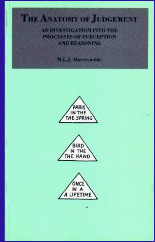M.L.J. Abercrombie (1909-1984) carried out some pionnering research in group work as a learning tool for students of medicine and architecture and in education as a whole. Abercrombie used her considerable experience in teaching zoology to apply S.H.Foulkes´ group analytical principles to the educational field.
 We thought it important to include the translation of Jane Abercrombie´s texts because it describes very clearly what the work done in a group analytical group contributes to the field of education and research.
We thought it important to include the translation of Jane Abercrombie´s texts because it describes very clearly what the work done in a group analytical group contributes to the field of education and research.
The main goal of the author´s research is the students´ and patients´ relationships with figures of authority and the way in which past experience conditions what is or is not observed about the object under consideration, what is really seen or should be seen one has learned to think. It is about an analysis of the judgment process, used as the title of one of her works: “The Anatomy of Judgment “(London: Hutchinson, 1960)
In her work, three separate lines of investigation may be distinguished: the selective and projective nature of perception, the difficulty that human beings experience with change and the subtlety and complexity of perception.
Abercrombie was greatly influenced by the psychoanalyst and groupanalyst S.H.Foulkes, the creator of group analysis. She joined Foulkes and other colleagues to found the Group Analytical Society (G.A.S.) in 1952.
Abercrombie found that free floating discussion in group helped the students to improve, among other aspects, their ability to discriminate between facts and opinions, to avoid false conclusions and to invent new strategies to solve new problems without being negatively influenced by past failures.
In conclusion, we might say that her most important finding is that the patient in a small group discussion in a group conducted on groupanalytical lines can learn how to think analytically rather than to learn in an unquestioning way.
- “Group Analysis and Higher Education” Jane Abercrombie, 1960

